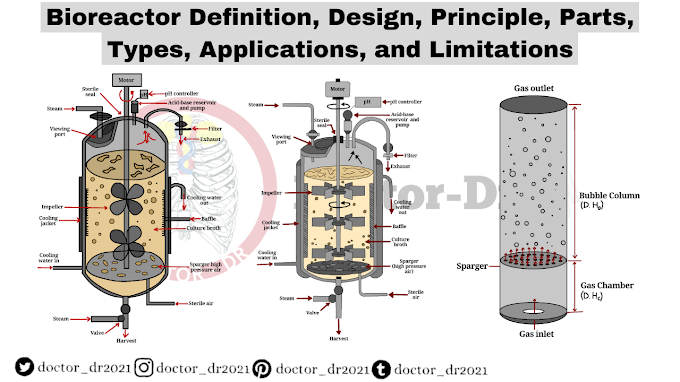Table of Contents
- Introduction to Continuous Culture
- Principle of Continuous Culture
- Process of Continuous Culture
- Applications of Continuous Culture
- Limitations of Continuous Culture
- References
Introduction to Continuous Culture
Continuous culture is a dynamic process where nutrients are consistently supplied to a bioreactor while the culture broth (comprising cells and metabolites) is simultaneously removed.
The culture broth volume remains constant due to the balanced rate of nutrient input and broth output, ensuring that consumed nutrients are replenished and toxic metabolites are removed.
Advantages of Continuous Culture
- Maintaining a constant working volume simplifies the scale-up of the culture, often using a constant power-to-volume strategy.
- Optimal conditions for maximum and prolonged product synthesis can be established.
- The process enables the production of stable product quality, as the steady-state maintains a homogeneous cell culture with consistent biomass and metabolite concentrations.
- Higher productivity per unit volume can be achieved because time-intensive activities, such as cleaning and sterilization, are minimized.
- Steady-state cultures can be sustained for extended periods—days, weeks, or even months—thereby reducing downtime and enhancing the economic competitiveness of the process.
Principle of Continuous Culture
A continuous flow system consists of a reactor into which reactants are pumped at a steady rate and from which products are emitted.
The factors governing their operation are:
- how material passes through the reactor (which depends upon its design);
- the kinetics of the reaction taking place.
- In continuous culture, growth-limiting nutrients can be maintained at steady-state concentrations, which permits microorganisms to grow at submaximal rates.
- In a steady-state, the cellular growth rate and environmental conditions, like the concentrations of metabolites, stay constant
- Moreover, in continuous culture, parameters such as pH, oxygen tension, the concentration of excretion products, and population densities can easily be monitored and controlled.
Process of Continuous Culture
- Continuous culture operates as an open system where one or more nutrient feed streams are consistently introduced, while an effluent stream containing cells, products, and residuals is continuously removed.
- A steady-state is achieved by ensuring the volumetric flow rates of the feed and effluent streams are equal. This maintains a constant culture volume and stable nutrient concentrations at steady-state levels.
- During this process, the exponential growth phase is extended, and the formation of unwanted byproducts is minimized. Continuous fermentation is monitored based on either microbial growth activity or by-product formation, categorized into the following methods:
A. Turbidostat method
- Cell growth is maintained at a constant rate, while the flow rate of fresh media varies.
- The system controls cell density by monitoring turbidity, which reflects the cell population. Fresh media is continuously supplied to sustain the set turbidity value.
B. Chemostat method
- Nutrients are supplied at a constant flow rate, with cell density regulated by the availability of essential growth nutrients.
- The growth rate is controlled by adjusting the concentration of critical substrates such as carbon, nitrogen, and phosphorus.
Key Features of Chemostat and Turbidostat Systems
- The medium and cells are continuously exchanged.
- Cell density remains constant.
- Growth occurs under steady-state conditions.
- The system operates as an open system.
C. Plug-flow reactor
- In this system, the culture solution flows through a tubular reactor without any back-mixing.
- Nutrients (reactants) enter the reactor in discrete “plugs” and move axially through the reactor.
- The culture medium flows steadily along the tube, with cells being recycled from the outlet back to the inlet.
Applications of Continuous Culture
- Continuous culture fermentation is employed in the production of single-cell proteins, organic solvents, and starter cultures.
- It is utilized in the manufacturing of products such as beer, fodder yeast, vinegar, and baker’s yeast.
- The process is widely applied in industrial production of secondary metabolites, including antibiotics produced by Penicillium or Streptomyces species.
- It has been tested for use with Corynebacterium glutamicum mutant B-6 in the production of L-lysine.
- Continuous culture is also implemented in municipal waste treatment processes.
Limitations of Continuous Culture
- Maintaining sterility over extended cultivation periods can be challenging, and downstream processing may become complex.
- Controlling the production of non-growth-related products is difficult, often necessitating the use of fed-batch culturing in combination with a continuous nutrient supply.
- The viscous and heterogeneous nature of the culture mixture can make it difficult to sustain filamentous organisms.
- Faster-growing strains may outcompete and replace the original product strain over time, leading to its loss.
References
- Blaby, I. K. (2011). Modes of Culture / Microbial. In Comprehensive Biotechnology (2nd ed., Vol. 1). Elsevier B.V. https://doi.org/10.1016/B978-0-08-088504-9.00034-9
- Brautaset, T., & Ellingsen, T. E. (2011). Lysine: Industrial Uses and Production. https://doi.org/10.1016/B978-0-08-088504-9.00220-8
- Ghosh, B., Bhattacharya, D., & Mukhopadhyay, M. (2018). Use of Fermentation Technology for Value-Added Industrial Research. Principles and Applications of Fermentation Technology, August, 141–161. https://doi.org/10.1002/9781119460381.ch8
- Herbert, D., Elsworth, R., & Telling, R. C. (1956). The Continuous Culture of Bacteria: A Theoretical and Experimental Study.
- Jaibiba, P., Vignesh, S. N., & Hariharan, S. (2020). Working Principle of Typical Bioreactors. In Bioreactors. INC. https://doi.org/10.1016/B978-0-12-821264-6.00010-3
- Kuenen, J. G., & Johnson, O. J. (2009). Continuous Cultures (Chemostats). Elsevier Inc.
- Kuila, A., & Sharma, V. (2018). Principles and Applications of Fermentation Technology. John Wiley & Sons, Inc. https://doi.org/10.1002/9781119460381
- Najafpour, G. D. (2015). Biochemical Engineering and Biotechnology. Elsevier. https://doi.org/10.1016/B978-044452845-2/50005-7
- Paulová, L. (2014). Advanced Fermentation Processes: Relationship Between Butanol Efflux and Butanol Tolerance of Clostridia. https://doi.org/10.1201/b15426-6
- Saran, S., Malaviya, A., & Chaubey, A. (2019). Introduction, Scope, and Significance of Fermentation Technology. Ch. 1, 1–25.
- Srivastava, A. K. (2011). Fed-Batch Fermentation: Design Strategies. Comprehensive Biotechnology, 1, 515–526. https://doi.org/10.1016/B978-0-08-088504-9.00112-4
- Yang, Y., & Sha, M. (2017). A Beginner’s Guide to Bioprocess Modes—Batch, Fed-Batch, and Continuous Fermentation.











